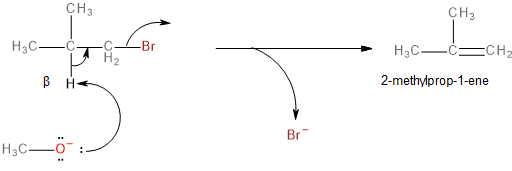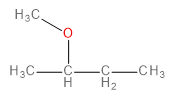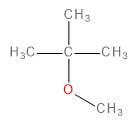Answer
36.9k+ views
Hint: Here we have an alkyl halide reacting with methoxide ion (\[C{H_3}{O^ - }\] ) in the presence of methanol (\[C{H_3}OH\]). The alkyl halide undergoes an elimination reaction called dehydrohalogenation.
Complete Step by Step Solution:
In this question, we have to predict the product that will be formed when 1-bromo-2-methylpropane reacts with a methoxide ion (\[C{H_3}{O^ - }\] ) in the presence of methanol (\[C{H_3}OH\]).
The methoxide ion is an electron-rich species having lone pairs on the oxygen atom. The carbon-bromine (\[C - Br\] ) bond in 1-bromo-2-methylpropane is polarised towards bromine because of its higher electronegativity. This makes the carbon atom a bit deficient in electrons. Therefore, one might think that the methoxide ion would substitute the bromine in a nucleophilic substitution reaction to form an ether as the final product.
However, this does not happen because the methoxide ion does not act as a nucleophile. Instead, it prefers to attack a hydrogen atom on 1-bromo-2-methylpropane and abstracts it as a proton (\[{H^ + }\]). Thus, the methoxide ion acts as a base.
When the methoxide ion acts as a base, it initiates an elimination reaction instead of a substitution reaction.
Although elimination reactions can occur via multiple mechanisms, in this case, the mechanism followed is a “bimolecular” elimination mechanism, also known as the E2 mechanism.
This is a single-step mechanism involving the abstraction of a beta-hydrogen as a proton and the elimination of bromine as a bromide ion (\[B{r^ - }\]) to form an alkene as the final, major product.

Image: Elimination reaction of 1-bromo-2-methylpropane to form 2-methylprop-1-ene
Thus, option C is correct.
Note: Nucleophilicity and basicity are not the same. Nucleophilicity refers to the ability of an electron-rich species to donate its lone pairs of electrons to electron-deficient species. Therefore, all nucleophiles are Lewis bases. But basicity refers to the ability of an electron-rich species to accept a proton. When an electron-rich species acts as an electron donor (i.e., a nucleophile), it causes substitution. When an electron-rich species acts as a proton acceptor (i.e., a base), it causes elimination. It is highly advised that students learn about the extent of nucleophilicities and basicities of different electron-rich species.
Complete Step by Step Solution:
In this question, we have to predict the product that will be formed when 1-bromo-2-methylpropane reacts with a methoxide ion (\[C{H_3}{O^ - }\] ) in the presence of methanol (\[C{H_3}OH\]).
The methoxide ion is an electron-rich species having lone pairs on the oxygen atom. The carbon-bromine (\[C - Br\] ) bond in 1-bromo-2-methylpropane is polarised towards bromine because of its higher electronegativity. This makes the carbon atom a bit deficient in electrons. Therefore, one might think that the methoxide ion would substitute the bromine in a nucleophilic substitution reaction to form an ether as the final product.
However, this does not happen because the methoxide ion does not act as a nucleophile. Instead, it prefers to attack a hydrogen atom on 1-bromo-2-methylpropane and abstracts it as a proton (\[{H^ + }\]). Thus, the methoxide ion acts as a base.
When the methoxide ion acts as a base, it initiates an elimination reaction instead of a substitution reaction.
Although elimination reactions can occur via multiple mechanisms, in this case, the mechanism followed is a “bimolecular” elimination mechanism, also known as the E2 mechanism.
This is a single-step mechanism involving the abstraction of a beta-hydrogen as a proton and the elimination of bromine as a bromide ion (\[B{r^ - }\]) to form an alkene as the final, major product.

Image: Elimination reaction of 1-bromo-2-methylpropane to form 2-methylprop-1-ene
Thus, option C is correct.
Note: Nucleophilicity and basicity are not the same. Nucleophilicity refers to the ability of an electron-rich species to donate its lone pairs of electrons to electron-deficient species. Therefore, all nucleophiles are Lewis bases. But basicity refers to the ability of an electron-rich species to accept a proton. When an electron-rich species acts as an electron donor (i.e., a nucleophile), it causes substitution. When an electron-rich species acts as a proton acceptor (i.e., a base), it causes elimination. It is highly advised that students learn about the extent of nucleophilicities and basicities of different electron-rich species.
Recently Updated Pages
If a wire of resistance R is stretched to double of class 12 physics JEE_Main

The path difference between two waves for constructive class 11 physics JEE_MAIN

What is the difference between solvation and hydra class 11 chemistry JEE_Main

IfFxdfrac1x2intlimits4xleft 4t22Ft rightdt then F4-class-12-maths-JEE_Main

Sodium chloride is purified by passing hydrogen chloride class 11 chemistry JEE_Main

Consider the following oxyanions PO43P2O62SO42MnO4CrO4S2O52S2O72 class 11 chemistry JEE_Main

Other Pages
The mole fraction of the solute in a 1 molal aqueous class 11 chemistry JEE_Main

If a wire of resistance R is stretched to double of class 12 physics JEE_Main

Lowering in vapour pressure is highest for A 02 m urea class 11 chemistry JEE_Main

An electric bulb has a power of 500W Express it in class 11 physics JEE_Main

Which of the following Compounds does not exhibit tautomerism class 11 chemistry JEE_Main

The ratio of speed of sound in Hydrogen to that in class 11 physics JEE_MAIN








